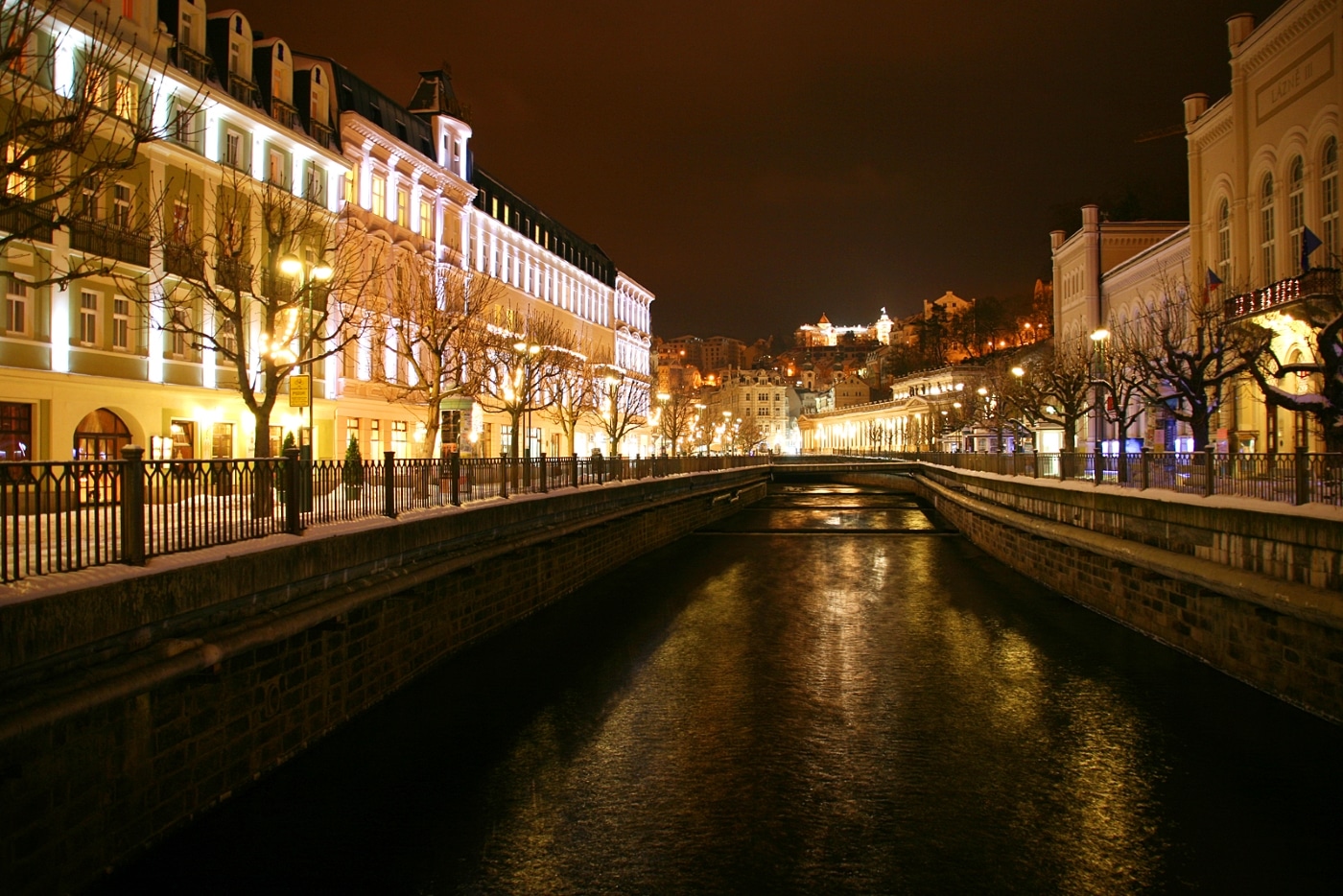Before there were hot stone massages and oxygen facials, Vichy showers and seaweed wraps, there were hot springs. For centuries, cultures around the globe turned to bubbling, mineral-rich natural springs to help heal a wide array of ailments, from joint pains to skin conditions. The ancient Romans in particular cultivated the idea of a central public bathhouse and the concept of “Saludis Per Aqua,” or “healing through water”—the root for the modern word, “spa.”
Following their popularity with those ancient bathers, mineral springs fell out of fashion for a few centuries, until the doctors of Western Europe began recommending the concept of “taking the cure” to their patients. It was during this revival that some of the most famous wellness destinations of Europe were established, including places like Bath, England, and Baden-Baden, Germany—and the historic spa towns of the Czech Republic.
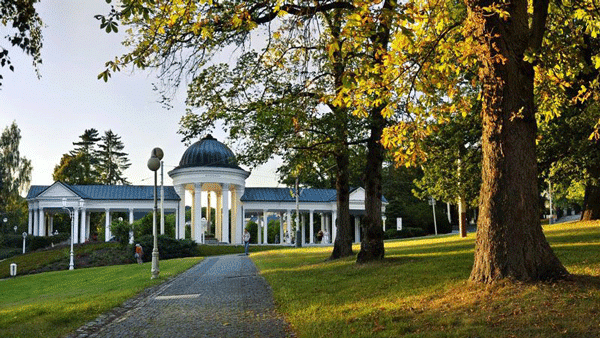
The Czech Republic’s three most famous spa towns are located in the region of Bohemia, set along the country’s western edge. Karlovy Vary, Marianske Lázně, and Frantiskovy Lázně—also known as Carlsbad, Marienbad, and Franzenbad, respectively—each still boast the ornate architecture and regal charm of their 18th to early 20th century heydays, and also still offer the authentic water treatments that had the elite of those times flocking to Bohemia. Today, many doctors still prescribe the area’s carbonated waters as treatment for everything from sinus and joint problems to obesity, digestive tract issue, infertility, and even gum disease; note that the unique mineral content of each town’s water makes them effective for different ailments, so patients are typically prescribed a visit to a specific town. While relaxing massages and other standard spa services can be enjoyed at these spas, these doctor-overseen services favor long-lasting health results over pampering, and are often more “traditional” (read “clinical”) over luxurious. For those seeking wellness, however, the results speak for themselves—as I learned on a recent thermal tour of the region.
Karlovy Vary
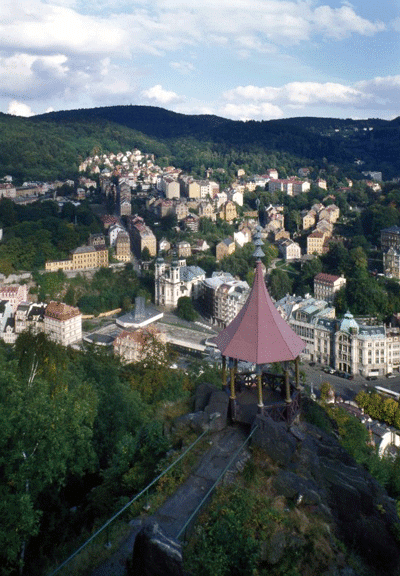
Upon landing at Prague Vaclav Havel Airport, I hit the highway northwest towards the largest, and most visited, of all the spa towns, Karlovy Vary, about 80 miles from Prague. Just before reaching town, I made a stop at the factory and showroom of Moser, one of the country’s top crystal and glass producers. Founded in 1893, Moser has created stunning tableware and decorative pieces for Prussian emperors and Persian shahs, along with generations of Czechs. There are Moser shops in the center of Karlovy Vary and in Prague, but this location features a museum, shop, and a working factory where you can watch glassblowers craft the elaborate pieces.
Then it was on to the cobblestone streets of Karlovy Vary, a town established in the 14th century by Emperor Charles IV after—as the legend goes—he accidentally stumbled upon the area’s thermal springs while out on a hunt. Following the Emperor’s lead, people have been coming here to take the waters ever since, and most of the current architecture is the result of the mineral spa boom of the 1700’s and 1800’s. Today, in addition to the wellness activities, the town is famous for its annual International Film Festival—which draws Hollywood stars and notable film premiers—and is a popular weekend getaway spot for Prague residents; it’s also served as a backdrop for movies like “Casino Royale.”
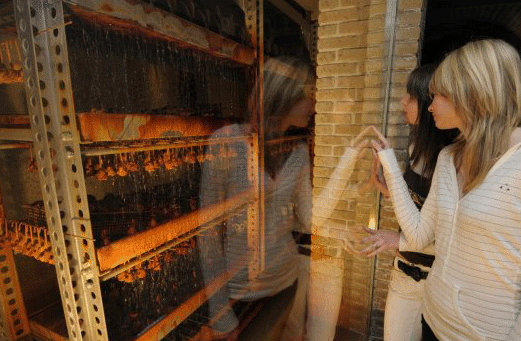
Set at the conflux of the Ohre and Tepla rivers, Karlovy Vary is home to 13 main hot springs and about 300 smaller pools. The central historic district is full of spas and bathhouses that draw from these springs, and there are beautiful fountains and taps around town from which you can fill water bottles with the warm, mineral-rich (but not exactly fragrant) liquid. (In addition to offering therapies that use the water, all the spa towns encourage visitors to drink plenty of the thermal waters by offering free taps and fountains scattered around the historic districts–many housed in ornate gazebos or “tap rooms.”)
There are countless spas of varying size and quality here, but one of the best places to get a sense of the area’s wellness history is the Castle Spa, set in the center of the old town’s “spa zone.” Though the current incarnation of the facility dates back just to 2001, the spa has roots in the early-20th century, when a large architectural project was undertaken to connect two main colonnades and protect one of the most important thermal springs. Today, behind the preserved historic facade sits an ornate, Old world-style multi-level complex offering treatment packages lasting anywhere from one hour to one week; the latter includes medical consults and results-oriented treatments such as water inhalations, oxygen therapy, gum irrigation, and underwater massages. The spa also owns two springs, and has a beautiful pool filled with thermal water—the only such pool in the Czech Republic.
Franstiskovy Lázně
After a few days enjoying the therapies—and lively, tourist-heavy atmosphere—of Karlovy Vary, it was off to one of its more sedate spa sisters. Located about 30 minutes from Karlovy Vary, Franstiskovy Lázně—or Franzenbad, named for Emperor Francis II—may have a population of just around 6,000, but it was once the most important spa town in the region. First discovered in the 1500’s and used in health regimes, the town’s slightly carbonated mineral waters were latter bottled and sold all over Germany, at one point selling more than the waters of all the German spa towns combined. In its heyday, the town housed 24 mineral springs (depending on the season, 12 to 23 are still in operation), as well as one of the first peat pulp baths in the world.
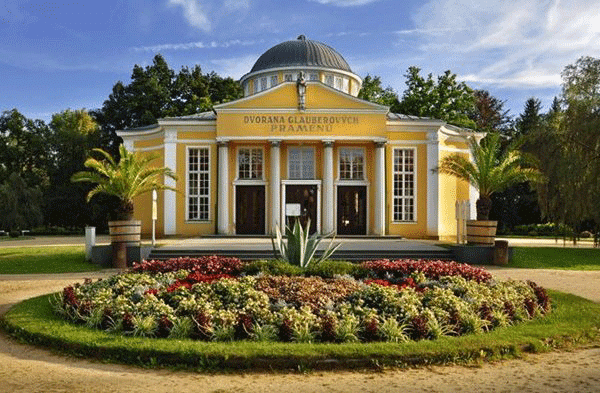
This town’s spas lean heavily towards the clinical, with clients coming to treat circulation, heart, blood pressure, and rheumatoid conditions in particular. In addition to thermal water services, many spas here offer mud treatments that use a heated mixture of local mud and mineral water; these are particularly effective for muscular and joint pain. At the Imperial Hotel, guests accent water treatments like carbon, peal and whirlpool baths, mud wraps, and gas injections with hot and cold sauna circuits. The hotel is equipped with a full medical team, and serves four types of spa cuisine in its restaurant.
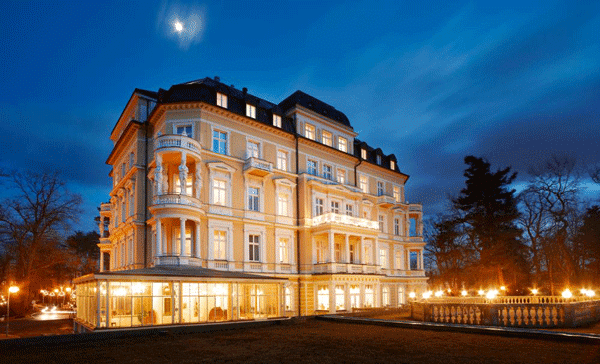
Until 1945, the majority of the town’s residents were German, and you can still see evidence of the Austro-Hungarian architectural influences of the 18th and 19th centuries when strolling around, particularly in the churches, parks, and tap gazebos. For a taste of modern-day Frantiskovy Lázně, check out the Aquaform water park (guests of the Imperial enjoy discounted admission)—a family-friendly spot that’s more about water slides, caves and “massage walls” than therapeutic programs.
Marianske Lázně
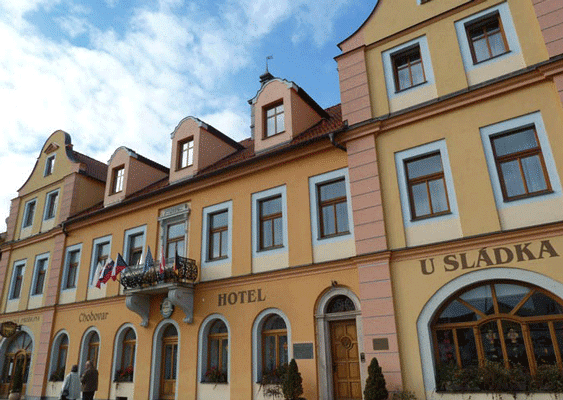
Before heading to the last of the spa towns, I made a detour to the village of Chodová Planá, just outside Marianske Lázně, to check out a place that mixes two of the Czech Republic’s signature offerings: mineral water and beer. Run by the noted Chodovar Brewery (which also offers tours), the Pravé Pivní Lázně Beer Spa treats guests to a relaxing soak in a mixture of thermal water, beer, and grain used in beer fermentation—plus a cold brew to enjoy during the bath. The combination of enzymes and minerals is particularly good for the skin, and baths can be followed up with massages or applications of hot grain packs for further relaxation.
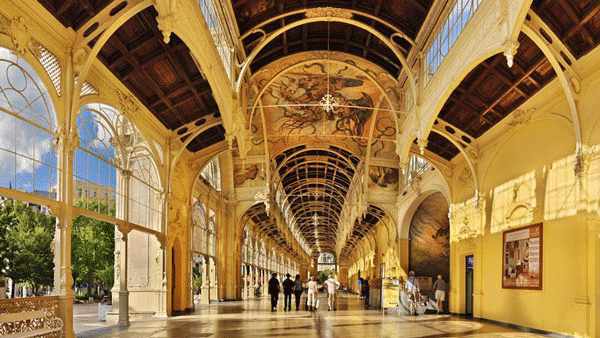
Then finally it was on to Marianske Lázně, a jewel-box town of lovely parks, elegant, historic buildings, and mountain views. Immortalized in the title of French director Alain Resnais’ groundbreaking 1961 film, “Last Year at Marienbad,” (though the film doesn’t actually take place here), Marianske Lázně’s roots go back to the 14th century, when its carbonated springs belonged to the monks of the Tepl Abbey. In the late 1700’s, it was the work of the abbey’s physician in proving the water’s curative properties that helped make the town a popular wellness destination. By the early 1900’s, close to a million bottles of mineral water from the town were exported every year, while over time the town regularly hosted boldface names like the writer Johann Wolfgang Goethe, composer Frederic Chopin, Russian Czar Nicolas II, and even Thomas Edison. A Chopin museum, located in the house in which he used to stay, honors his time here with exhibits and concerts
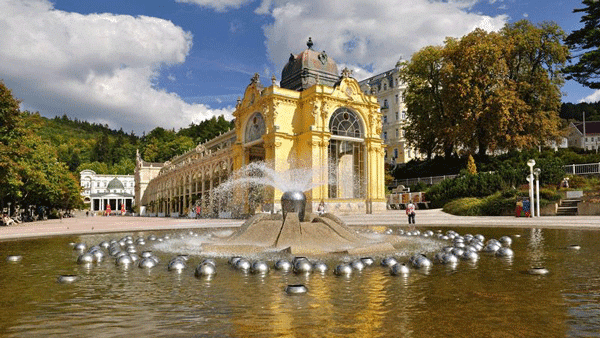
Today, there are still 100 mineral springs in the area, of which 53 are tapped with about 40 in the main town. Each spring’s water is used to treat a different ailment with Cross Spring, the most famous, known for its laxative properties, while Rudolph’s Spring is good for urinary tract issues. Most of the springs are covered by colonnades or pavilions and between treatments guests often take a stroll around the center to admire the structures. Don’t miss the dramatic Main Colonnade, a long gallery of cast-iron arches, as well as the Singing Fountain where water “dances” to light and music in the adjacent park. All these spots are easily accessible from a base at the Nove Lázně or Maria Spa hotels, part of a historic wellness complex. In between all the water, be sure to try a Spa Wafer, a local specialty cookie made here since 1856 (and best eaten warm).
http://www.stories.czechtourism.com
https://travelsquire.com/ts/czech-republic/stories/
The country code for the Czech Republic is 420.
Where to Stay:
Grandhotel Pupp: One of the iconic Grande Dame hotels of Europe, the majestic Pupp has watched over the heart of Karlovy Vary since the 18th century. Along with 228 classically furnished rooms and suites, the hotel has a new wellness center with steam baths, salt caves, an ice fountain, themed pools, and full menu of services. 420-353-109-111; www.pupp.cz.
Nové Lázně: There’s plenty of history at this 97 room upscale spa hotel, set in the center of Marianske Lázně where guests can bathe in the Roman Baths, surrounded by columns from 1896; have a treatment in what was once King Edward’s private bath cabin; and try their luck at the Italian Neo-Renaissance-style casino. The vast wellness facilities also include dry carbon gas baths, Kneipp circuits and on-site springs. 420-354-644-111; www.danubiushotels.com/our-hotels-marianske-lazne/danubius-health-spa-resort-nove-lazne
Maria Spa: The newly-renovated, 20-room wing is part of the Nové & Centrální Lázně spa complex, but has been designed to feel like a boutique hotel within the larger complex, with its own reception, restaurant, and spa; the latter offers some high-tech therapies like carbon and oxygen treatments. 420-354-634-111; www.danubiushotels.com/our-hotels-marianske-lazne/maria-spa-courtyard
Imperial Hotel: In Frantiskovy Lázně, this hotel has 49 basic—but new and comfortable—rooms and suites, as well as wellness and dining facilities; the latter offering a choice of four diet-specific menus. 420-844-223-113; www.hotel-imperial-frantiskovy-lazne.az-ubytovani.net
What to Eat:
Spa guests typically eat at their hotels, since meals are often included and specialized diets are part of the total wellness program. Some standout hotels for food include:
Nové Lázně: The Royal Restaurant serves Czech and international fare, and caters to a wide array of dietary restrictions—including fasting programs. Meanwhile, the historic Viennese Cafe is popular for its summer terrace and sweets selection. 420-354-644-111; www.danubiushotels.com/our-hotels-marianske-lazne/danubius-health-spa-resort-nove-lazne
Dvorak Spa Hotel: In Karlovy Vary, skip the overpriced fare at the Grandhotel Pupp for the restaurant at the Dvorak Hotel, which serves typical Bohemian dishes and international items, along with tasty low-calorie interpretations. The Opera Bar and Cafe honors the Viennese coffeehouse tradition with specialty brews and Austrian pastries. The hotel is worth staying at, as well. 420-353-102-111; www.vi-hotels.com/en/dvorak/restaurant-cafe/
What to See and Do:
Explore: The old town centers of all three spa towns are filled with historic buildings, charming cobblestoned lanes, lively cafes and restaurants, and shops brimming with souvenirs like Czech crystal, Becherovka liquor, and signature ceramic mugs with built-in straws, which is what spa-goers traditionally use to drink the mineral water. In Karlovy Vary you may want to join a walking tour to get the town’s history and stories in detail, but in smaller Marianske Lázně and Frantiskovy Lázně, it’s easy to wander around by yourself. Be sure to check out the beautiful Victorian-era covered arcade in Marianske Lázně, and each town’s network of ornate mineral water pumps, taps, and fountains.
Moser Glassworks: The Czech Republic is known for its artisan crystal and glasswork, and no brand is more well-known than the 155-year-old Moser. There are Moser shops in Prague and Karlovy Vary, but it’s worth venturing just outside of Karlovy Vary (along the route from Prague’s international airport) to visit the historic factory. There you can learn about the industry and the art, watch glassblowers at work and then pick-up some souvenirs in the boutique. Guided tours are offered every 30 minutes between 9am -2:30 p.m. and are available in English. 420-353-416-132; www.moser-glass.com.
Take the Waters: It’s all about thermal water in these town, so be sure to drink it, soak in it, and get treatments with it as much as possible. In Karlovy Vary, enjoy a swim in a thermal water pool and a large roster of services at the Castle Spa (420-353-225-502; www.zamecke-lazne.com/en), while in Marianske Lázně, you can bathe in King Edward’s private spa tub at the historic Nové Lázně spa (420-354-644-111; www.danubiushotels.com/our-hotels-marianske-lazne/danubius-health-spa-resort-nove-lazne.) in Frantiskovy Lázně, the Imperial Spa menu includes mud baths, pearl and carbon baths and hot-and-cold sauna circuits (420-844-223-113; www.hotel-imperial-frantiskovy-lazne.az-ubytovani.net/accommodation.htm.)Each town also has free taps and pumps dotted around the historic neighborhoods, so bring an empty water bottle—or one of the traditional ceramic cups with built-in straw—and fill ’em up.
Pravé Pivní Lázně Beer Spa: Soak in a mixture of mineral water, beer, and fermentation grains at this fun, brewery/spa just outside of Marianske Lázně—then be sure to sample some of the house brews. 420-374-617-100; www.chodovar.cz

